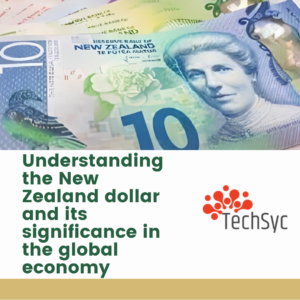” Navigating The Waves : The New Zealand Dollar’s Economic Journey”
The New Zealand Dollar’s profitable trip has been a wild lift of highs and lows. From its one- time high in the early 2000s to its dip during the global fiscal extremity, the NZD has clearly seen its fair share of turbulence.
Still, despite these challenges, the country has managed to stay round and indeed rebound in recent times. In this blog post, we will explore the NZD’s turbulent history and take a look at where it stands at the moment. We will bandy the factors that have told its performance and what the future holds for the currency.
1.Understanding the New Zealand dollar and its significance in the global economy 
The New Zealand dollar’s ( NZD), frequently referred to as the” kiwi,” holds significant significance in the global frugality. As the sanctioned currency of New Zealand, it plays a vital part in transnational trade, investment, and tourism. Understanding the NZD and its significance in the global frugality requires a near look at the country’s profitable fundamentals, trading mates, and request dynamics.
New Zealand has a fairly small frugality compared to global bootstrappers like the United States or China. Still, its geographic position, abundant natural coffers, and strong agrarian sector have made it an important player in the global demand. New Zealand is a major exporter of agrarian products, similar to dairy, meat, and hair, which contribute significantly to its GDP. The NZD’s value in the global request is told by several factors.
First and foremost, interest rates play a pivotal part in determining the attractiveness of the currency to foreign investors. Advanced interest rates tend to attract foreign capital, driving up demand for the NZD and strengthening its value. Also, New Zealand’s trade connections with crucial husbandry like Australia, China, and the United States have a direct impact on the NZD’s performance.
Changes in the trading conditions, similar to tariffs or trade agreements, can significantly affect the currency’s exchange rate. Likewise, political developments in New Zealand, including choices, policy opinions, and transnational relations, can also impact the NZD’s value. Political stability and a favourable business terrain are frequently associated with a stronger currency.
2.The ups and downs of the New Zealand dollar’s exchange rate over the years
The New Zealand dollar’s ( NZD) has endured its fair share of highs and lows over the times. Its exchange rate has been on a rollercoaster lift, reflecting the country’s profitable performance and global request oscillations. One of the most notable ages in the NZD’s history was its each- time high in the early 2000s. At that time, the NZD was valued at around $0.88 against the US dollar’s .
The strong performance was driven by a combination of factors, including New Zealand’s robust profitable growth, high interest rates, and the global commodity smash. Still, the NZD’s fortunes snappily changed with the onset of the global fiscal extremity in 2008. As the extremity unfolded, investors crowded to safe- haven currencies, causing the NZD to dip. By March 2009, the NZD had fallen to around $0.50 against the US dollar’s , marking a significant decline.
In the times following the fiscal extremity, the NZD endured a period of volatility, told by colourful factors. Commodity prices, especially dairy, played a pivotal part in the NZD’s performance. As New Zealand’s largest import, oscillations in dairy prices had a direct impact on the currency’s value. Political developments also had an impact on the NZD’s exchange rate. choices, policy opinions, and transnational relations all played a part in shaping investor sentiment and, accordingly, the value of the NZD.
Likewise, profitable data releases, similar to GDP growth, affectation rates, and employment numbers, were nearly covered by investors. Positive profitable pointers frequently led to a strengthening of the NZD, while negative data had the contrary effect. Overall, the NZD’s exchange rate has been subject to colourful ups and downs over the times, reflecting both domestic and global profitable factors.
3.Key factors influencing the New Zealand dollar’s value, such as commodity prices, political developments, and economic data 
When it comes to understanding the value of the New Zealand dollar’s ( NZD), there are several crucial factors that play a pivotal part. These factors, including commodity prices, political developments, and profitable data, have a direct impact on the currency’s value and can greatly impact its performance in the global market.
Commodity prices, particularly for New Zealand’s largest import, dairy products, are a significant driver of the NZD’s value. Oscillations in global dairy prices can beget the currency to rise or fall, as changes in demand and force impact the country’s import earnings. When dairy prices are high, the NZD tends to strengthen, as foreign investors are attracted to the country’s strong agrarian sector.
Political developments also have a significant impact on the NZD’s value. choices, policy opinions, and transnational relations can all impact investor sentiment and, accordingly, the currency’s exchange rate. For illustration, a stable political terrain and favourable business programs are frequently associated with a stronger NZD, as they produce an seductive investment climate.
On the other hand, negative data can weaken the currency, signalling profitable challenges and implicit pitfalls. It’s important to note that these factors don’t operate in insulation, but rather interact with and impact each other. For illustration, political developments can impact commodity prices if they affect changes to trade programs or request access.
4.Impact of the COVID- 19 pandemic on the New Zealand dollar and the country’s economy 
The COVID- 19 epidemic has had a significant impact on the New Zealand dollar’s ( NZD) and the country’s frugality as a whole. Like numerous other countries around the world, New Zealand faced unknown challenges as it grappled with the goods of the global health extremity. One of the major impacts of the epidemic was the dislocation to transnational trade and tourism.
New Zealand, known for its graphic geographies and vibrant tourism assistance, endured a significant decline in callers due to trip restrictions and border closures.This drop in tourism had a direct impact on the country’s frugality and the value of the NZD. As a result, the NZD faced downcast pressure as the demand for the currency from transnational trippers and investors declined.
Also, the epidemic affected New Zealand’s major trading mates, including China, Australia, and the United States. The profitable downturn in these countries had a ripple effect on New Zealand’s exports, further impacting the NZD’s performance. With reduced demand for New Zealand’s agrarian products, similar to dairy and meat, the country’s import earnings were negatively affected, putting pressure on the NZD’s exchange rate.
Also, New Zealand’s strong agrarian sector and favourable trading connections are likely to play a part in supporting the NZD’s performance in the post-pandemic period. Overall, while the COVID- 19 epidemic has had a significant impact on the New Zealand dollar’s and the country’s frugality, there’s a stopgap for a brighter future as New Zealand navigates the swells of recovery and rebuilds its profitable adaptability.
5.predictions and future outlook for the New Zealand dollar’s economic journey. 
As we look ahead to the future, there are several factors that will shape the New Zealand dollar’s( NZD) profitable trip. While it’s delicate to prognosticate with certainty, there are some crucial trends and developments that give sapience into what may lie ahead for the NZD. One important factor to consider is the recovery from the COVID- 19 epidemic.
As vaccines come more extensively available and travel restrictions are eased, there’s sanguinity for an answer in New Zealand’s frugality. The resumption of transnational tourism, which is a significant contributor to the country’s GDP, is anticipated to have a positive impact on the NZD’s performance. As excursionists flock back to New Zealand’s beautiful geographies and unique guests , the demand for the NZD is likely to strengthen.
Likewise, New Zealand’s strong agrarian sector, which has been a driving force behind the country’s exports, is anticipated to play a pivotal part in supporting the NZD’s value. The global demand for New Zealand’s high- quality agrarian products, similar to dairy and meat, is likely to continue, furnishing a solid foundation for the currency.
Geopolitical pressures, trade controversies, and profitable oscillations in crucial trading mates could impact the NZD’s performance. It’ll be pivotal to nearly cover these factors and their implicit counter accusations for the currency. Overall, while the future of the NZD’s profitable trip isn’t set in gravestone, there are reasons to be cautiously auspicious. The country’s adaptability, strong agrarian sector, and visionary response to the COVID- 19 epidemic give a solid foundation for the NZD’s performance.
Conclusion :
In conclusion, the New Zealand Dollar’s profitable trip has been one of adaptability, rigidity, and growth. Despite facing multitudinous challenges, similar as the global fiscal extremity and the impact of the COVID- 19 epidemic, New Zealand has managed to ride the storms and crop stronger.
The significance of the NZD in global frugality can not be exaggerated. Its value is told by a myriad of factors, including interest rates, trade connections, political developments, and profitable data.
Also Read : Top 50 IT Companies In USA
Also Read : 5 uses of penetration testing uses

